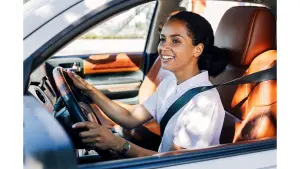Top 10 Safe Driving Tips For New Drivers
Driving is an important skill to master and a great privilege to have. As a new driver, it is especially important to understand the basics of defensive driving. Safe driving tips for new drivers involve driving in a manner that reduces the chances of being involved in an accident or other dangerous situation. Here are the top 10 defensive driving tips for new drivers to keep themselves and others safe on the road.
- 1. Always wear your seat belt.
- 2. Follow the speed limit and drive at a safe speed for the conditions.
- 3. Avoid distractions while driving.
- 4. Be alert and attentive at all times.
- 5. Don’t drive under the influence of alcohol or drugs.
- 6. Don’t Drive after taking prescription medication.
- 7. Avoid aggressive driving. Don’t try to pass other vehicles or change lanes frequently, and don’t tailgate.
- 8. Always signal when changing lanes or turning.
- 9. Check your mirrors regularly, and make sure you can see them all around your vehicle.
- This will help you to stay aware of what’s happening in the surrounding of your vehicle and make safe driving decisions.
- 10. Always Turn on headlights when windshield wipers are on
1. Always wear your seat belt.
It’s the law, and it can save your life in the event of a collision
Wearing a seat belt is an important safety measure that can help protect you in the event of a car crash. It’s also the law in most states in the United States, to wear a seat belt while driving or riding in a car. Seat belts are designed to keep you securely in your seat and prevent you from being ejected from the vehicle, which can lead to serious injuries or even death. In the event of a collision, a seat belt can help to reduce the impact of the collision on your body, which can help to prevent serious injuries or even save your life. So, always make sure to wear your seat belt, even if you’re only going for a short drive. It’s a simple step that can make a big difference in keeping you safe on the road.
2. Follow the speed limit and drive at a safe speed for the conditions.
Don’t speed or tailgate, and avoid sudden lane changes.
Driving at a safe speed is an important part of being a responsible and safe driver. The speed limit is the maximum legal speed that you are allowed to drive on a particular road, but it is not necessarily the safe speed for all conditions. When driving, you should always adjust your speed to match the road conditions, traffic, and weather. For example, if it is raining or snowing, you should slow down to allow for increased stopping distances and reduced visibility. Similarly, if you are driving on a crowded highway or in a residential area, you should reduce your speed to allow for more reaction time and avoid collisions with other vehicles or pedestrians.
3. Avoid distractions while driving.
Don’t use your phone or other electronic devices while behind the wheel.
Distracted driving is a major cause of car accidents and fatalities on the road. It is important to avoid any activities that could take your attention away from the road while driving. This includes using your phone or other electronic devices, such as a GPS or music player. These devices can be a major distraction and can make it difficult for you to concentrate on the road and react to changing traffic conditions. If you need to use your phone or other electronic devices while driving, make sure to pull over to a safe location before using it. It’s also a good idea to put your phone in silent or Do Not Disturb mode so you won’t be tempted to look at it while driving. By avoiding distractions and staying focused on the road, you can help to keep yourself and others safe on the road.
4. Be alert and attentive at all times.
Keep an eye on other vehicles, pedestrians, and bicycles, and be prepared to react to changing conditions.
As a driver, it is important to always be alert and attentive while behind the wheel. This means keeping an eye on other vehicles, pedestrians, and bicycles, and being prepared to react to any changes in traffic or road conditions. Being alert and attentive can help you to avoid collisions and other accidents, and can also help you to respond quickly in emergency situations. To help stay alert and attentive, avoid driving when you are fatigued or under the influence of alcohol or drugs. These substances can impair your ability to concentrate and react to changing conditions.
5. Don’t drive under the influence of alcohol or drugs.
These substances can impair your judgment and reaction time, putting you and others at risk.
In any state in the USA, it is illegal to drive with a blood alcohol concentration (BAC) of 0.08% or higher. However, even a small amount of alcohol or drugs can impair your driving ability, so it’s best to avoid driving altogether if you’ve been drinking or using drugs. If you do need to drive, make sure to plan ahead and arrange for a designated driver or a ride-sharing service. By avoiding driving under the influence, you can help to keep yourself and others safe on the road.
6. Don’t Drive after taking prescription medication.
Some medications can impair your driving ability.
It is generally not recommended to drive after taking medicine, especially if the medication affects your ability to think or react quickly. Some medications can cause drowsiness, dizziness, or blurred vision, which can make driving dangerous. It is important to read the label on your medication and follow the instructions carefully. If the label advises against operating heavy machinery or driving, it is best to avoid driving until the effects of the medication have worn off. It is also a good idea to consult with your doctor or pharmacist before taking any medication to determine if it is safe to drive after taking it.
7. Avoid aggressive driving. Don’t try to pass other vehicles or change lanes frequently, and don’t tailgate.
Instead, stay calm and follow the flow of traffic and posted speed limits.
Aggressive driving is a major cause of car accidents and fatalities on the road. It includes behaviors such as speeding, tailgating, sudden lane changes, and ignoring traffic laws. These behaviors can put yourself and others at risk and can increase the likelihood of a collision.
To avoid aggressive driving, it’s important to stay calm and patient while behind the wheel. Don’t try to rush or speed to get to your destination, as this can lead to careless or reckless driving. Instead, follow the flow of traffic and the posted speed limits, and give yourself plenty of time to get to your destination. If another driver is behaving aggressively, don’t engage with them or try to compete with them. Instead, maintain a safe distance and let them pass if possible. By avoiding aggressive driving and staying calm on the road, you can help to reduce the risk of accidents and keep yourself and others safe.
8. Always signal when changing lanes or turning.
This lets other drivers know what you are doing and helps to prevent accidents.
Signaling is an important part of safe driving, as it helps to communicate your intentions to other drivers on the road. Whenever you change lanes or turn, you should always use your turn signals to let other drivers know what you’re doing. This helps to prevent accidents and collisions, as it gives other drivers time to react and adjust their own driving accordingly.
To use your turn signals, simply activate the signal lever on your steering wheel. This will cause the appropriate turn signal light to flash, letting other drivers know which direction you’re turning or which lane you’re changing into. Be sure to signal well in advance of making your turn or lane change, so that other drivers have time to see and react to your signal. By signaling when changing lanes or turning, you can help to prevent accidents and keep yourself and others safe on the road.
9. Check your mirrors regularly, and make sure you can see them all around your vehicle.
This will help you to stay aware of what’s happening in the surrounding of your vehicle and make safe driving decisions.
Checking your mirrors is an important part of safe driving, as it helps you to be aware of your surroundings and to monitor other vehicles on the road. By regularly checking your mirrors, you can keep track of what’s happening behind and to the sides of your vehicle, which can help you to avoid collisions and other accidents.
To check your mirrors properly, you should first adjust them to give you the best view possible. This may involve moving the mirrors up or down, or tilting them to the left or right. You should also adjust your seat position so that you can see out of all of your mirrors comfortably. Once your mirrors are adjusted, you should regularly glance at them while driving to check for other vehicles, pedestrians, or other hazards. This should be done in addition to looking over your shoulder and using your blind spot mirrors if your vehicle has them. By regularly checking your mirrors, you can help to avoid accidents and keep yourself and others safe on the road.
10. Always Turn on headlights when windshield wipers are on
Yes , it is required by law
It is important to turn on headlights when using windshield wipers for rain because it improves visibility for both the driver and other road users. This is especially crucial during adverse weather conditions such as snow, or fog as well. In addition, it is the law in most states in the USA to use headlights when using windshield wipers, so it is important to follow this rule to avoid any potential penalties.
By following these tips and staying focused and attentive while driving, you can improve your safe driving habits and help to prevent accidents.






